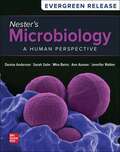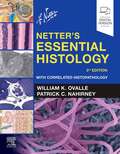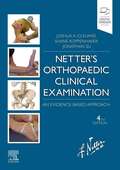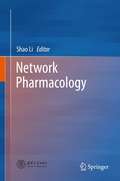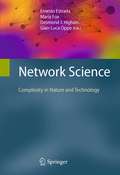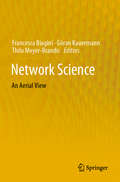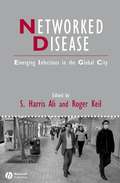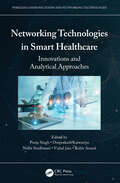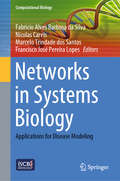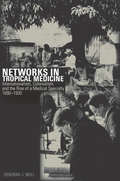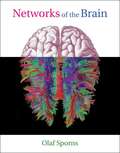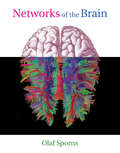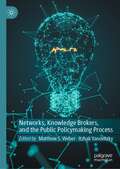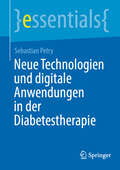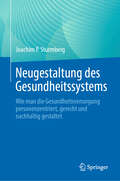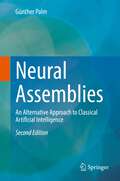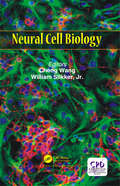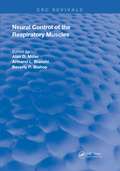- Table View
- List View
Nester's Microbiology: A Human Perspective
by Denise Anderson Sarah Salm Mira Beins Ann Auman and Jennifer WalkerPerfect for the non-major/allied health student (and also appropriate for mixed majors courses), this text provides a rock solid foundation in microbiology. It has a concise and readable style, covers the most current concepts, and gives students the knowledge and mastery necessary to understand advances of the future. By carefully and clearly explaining the fundamental concepts, using a body systems approach in the coverage of disease, and offering vivid and appealing instructional art, Microbiology: A Human Perspective draws students back to their book again and again!
Netter's Essential Histology: With Correlated Histopathology (Netter Basic Science Series)
by William K. Ovalle Patrick C. NahirneyWith strong correlations between gross anatomy and the microanatomy of structures, Netter’s Essential Histology, 3rd Edition, is the perfect text for today’s evolving medical education. Concise and easy to use, it integrates gross anatomy and embryology with classic histology slides and state-of-the-art scanning electron microscopy, offering a clear, visual understanding of this complex subject. Additional histopathology images, more clinical boxes, and new histopathology content ensure that this textbook-atlas clearly presents the most indispensable histologic concepts and their clinical relevance. <p>• Helps you recognize both normal and diseased structures at the microscopic level with the aid of succinct explanatory text as well as numerous clinical boxes. <p>• Features more histopathology content and additional clinical boxes to increase your knowledge of pathophysiology and clinical relevance. <p>• Includes high-quality light and electron micrographs, including enhanced and colorized electron micrographs that show ultra-structures in 3D, side by side with classic Netter illustrations that link your knowledge of anatomy and cell biology to what is seen in the micrographs. <p>• Provides online access to author-narrated video overviews of each chapter, plus Zoomify images and Virtual Slides that include histopathology and can be viewed at different magnifications. <p>• Enhanced eBook version included with purchase. Your enhanced eBook allows you to access all of the text, figures, and references from the book on a variety of devices.
Netter's Orthopaedic Clinical Examination: An Evidence-Based Approach (Netter Clinical Science)
by Joshua Cleland Shane Koppenhaver Jonathan SuOffering a thorough, highly illustrated review of the musculoskeletal physical exam, this practical guide covers relevant anatomy, pathoanatomy, and special tests using the well-known art of Dr. Frank H. Netter as well as clinical photographs. Netter’s Orthopaedic Clinical Examination: An Evidence-Based Approach, 4th Edition, provides the information you need to assess the reliability and diagnostic utility of musculoskeletal physical exams and incorporate evidence into your clinical decision making. Summary tables and carefully selected references highlight best available evidence, providing a practical resource for the busy student and clinician.
Network Pharmacology
by Shao LiThis book introduces “network pharmacology” as an emerging frontier subject of systematic drug research in the era of artificial intelligence and big data. Network Pharmacology is an original subject of fusion system biology, bioinformatics, network science and other related disciplines. It emphasizes on starting from the overall perspective of the system level and biological networks, the analysis of the laws of molecular association between drugs and their treatment objects, reveals the systematic pharmacological mechanisms of drugs, and guides the research and development of new drugs and clinical diagnosis and treatment. After it was proposed, network pharmacology has been paid attention by researchers, and it has been rapidly developed and widely used. In order to systematically reveal the biological basis of diagnosis and treatment in traditional Chinese medicine and modern medicine, we proposed a new concept of "network target" for the first time, which has become the core theory of "network pharmacology". The core principle of a network target is to construct a biological network that can be used to decipher complex diseases. The network is then used as the therapeutic target, to which multicomponent remedies are applied. This book mainly includes four parts: 1) The concept and theory of network pharmacology; 2) Common analysis methods, databases and software in network pharmacological research; 3) Typical cases of traditional Chinese medicine modernization and modern drug research based on network pharmacology; 4) Network pharmacology practice process based on drugs and diseases.
Network Science
by Desmond J. Higham Gian-Luca Oppo Ernesto Estrada Maria FoxNetwork Science is the emerging field concerned with the study of large, realistic networks. This interdisciplinary endeavor, focusing on the patterns of interactions that arise between individual components of natural and engineered systems, has been applied to data sets from activities as diverse as high-throughput biological experiments, online trading information, smart-meter utility supplies, and pervasive telecommunications and surveillance technologies. This unique text/reference provides a fascinating insight into the state of the art in network science, highlighting the commonality across very different areas of application and the ways in which each area can be advanced by injecting ideas and techniques from another. The book includes contributions from an international selection of experts, providing viewpoints from a broad range of disciplines. It emphasizes networks that arise in nature--such as food webs, protein interactions, gene expression, and neural connections--and in technology--such as finance, airline transport, urban development and global trade. Topics and Features: begins with a clear overview chapter to introduce this interdisciplinary field; discusses the classic network science of fixed connectivity structures, including empirical studies, mathematical models and computational algorithms; examines time-dependent processes that take place over networks, covering topics such as synchronisation, and message passing algorithms; investigates time-evolving networks, such as the World Wide Web and shifts in topological properties (connectivity, spectrum, percolation); explores applications of complex networks in the physical and engineering sciences, looking ahead to new developments in the field. Researchers and professionals from disciplines as varied as computer science, mathematics, engineering, physics, chemistry, biology, ecology, neuroscience, epidemiology, and the social sciences will all benefit from this topical and broad overview of current activities and grand challenges in the unfolding field of network science.
Network Science: An Aerial View
by Francesca Biagini Göran Kauermann Thilo Meyer-BrandisThis book provides an overview of network science from the perspective of diverse academic fields, offering insights into the various research areas within network science. The authoritative contributions on statistical network analysis, mathematical network science, genetic networks, Bayesian networks, network visualisation, and systemic risk in networks explore the main questions in the respective fields: What has been achieved to date? What are the research challenges and obstacles? What are the possible interconnections with other fields? And how can cross-fertilization between these fields be promoted? Network science comprises numerous scientific disciplines, including computer science, economics, mathematics, statistics, social sciences, bioinformatics, and medicine, among many others. These diverse research areas require and use different data-analytic and numerical methods as well as different theoretical approaches. Nevertheless, they all examine and describe interdependencies, associations, and relationships of entities in different kinds of networks. The book is intended for researchers as well as interested readers working in network science who want to learn more about the field – beyond their own research or work niche. Presenting network science from different perspectives without going into too much technical detail, it allows readers to gain an overview without having to be a specialist in any or all of these disciplines.
Networked Disease: Emerging Infections in the Global City (IJURR Studies in Urban and Social Change Book Series #44)
by Roger Keil S. Harris AliA collection of writings by leading experts and newer researchers on the SARS outbreak and its relation to infectious disease management in progressively global and urban societies. Presents original contributions by scholars from seven countries on four continents Connects newer thinking on global cities, networks, and governance in a post-national era of public health regulations and neo-liberalization of state services Provides an important contribution to the global public debate on the challenges of emerging infectious disease in cities Examines the impact of globalization on future infectious disease threats on international and local politics and culture Focuses on the ways pathogens interact with economic, political and social factors, ultimately presenting a threat to human development and global cities Employs an interdisciplinary approach to the SARS epidemic, clearly demonstrating the value of social scientific perspectives on the study of modern disease in a globalized world
Networking Technologies in Smart Healthcare: Innovations and Analytical Approaches (Wireless Communications and Networking Technologies)
by Omprakash Kaiwartya Pooja Singh Vishal Jain Nidhi Sindhwani Rohit AnandThis text provides novel smart network systems, wireless telecommunications infrastructures, and computing capabilities to help healthcare systems using computing techniques like IoT, cloud computing, machine and deep learning Big Data along with smart wireless networks. It discusses important topics, including robotics manipulation and analysis in smart healthcare industries, smart telemedicine framework using machine learning and deep learning, role of UAV and drones in smart hospitals, virtual reality based on 5G/6G and augmented reality in healthcare systems, data privacy and security, nanomedicine, and cloud-based artificial intelligence in healthcare systems. The book: • Discusses intelligent computing through IoT and Big Data in secure and smart healthcare systems. • Covers algorithms, including deterministic algorithms, randomized algorithms, iterative algorithms, and recursive algorithms. • Discusses remote sensing devices in hospitals and local health facilities for patient evaluation and care. • Covers wearable technology applications such as weight control and physical activity tracking for disease prevention and smart healthcare. This book will be useful for senior undergraduate, graduate students, and academic researchers in areas such as electrical engineering, electronics and communication engineering, computer science, and information technology. Discussing concepts of smart networks, advanced wireless communication, and technologies in setting up smart healthcare services, this text will be useful for senior undergraduate, graduate students, and academic researchers in areas such as electrical engineering, electronics and communication engineering, computer science, and information technology. It covers internet of things (IoT) implementation and challenges in healthcare industries, wireless network, and communication-based optimization algorithms for smart healthcare devices.
Networking of Mutagens in Environmental Toxicology (Environmental Science and Engineering)
by Kavindra Kumar KesariThis book covers the latest environmental issues based on current research objectives. All chapters are fundamentally interlinked and focus on deciphering the networking of mutagens in environmental toxicity and human health. Our changing environment, climate, and lifestyle factors are growing concerns in the 21st century. The existing mutagens, either physical or chemical, are responsible for environmental toxicity. These toxicants are carcinogenic and not limited to naturally occurring chemicals or biologicals, but can also be man-made, such as 'radiation'. The networking of mutagens can have a broad range of effects on both the environment and human health. Accordingly, the respective chapters explore the networking of mutagens in connection with environmental toxicity, and address: 1. Extant types of man-made radiation and their effects on the environment and biological systems2. Heavy metal contaminations: Effects on environmental health3. Networking of environmental pollutants in the air, dust, soil, water, and natural toxins in the environment: Exposure and health4. The molecular interaction of environmental carcinogens with DNA: An oncoinformatics approach5. Fundamentals of nonotoxicity, carcinogenicity, mutagenic and neurotoxicity in environmental health6. The role of antioxidants and medicinal plants in reducing the impacts of disease-causing pollutants A sequel to Perspectives in Environmental Toxicology, this book highlights the latest developments in the field of environmental toxicology. It offers a valuable resource for researchers, scholars and graduate students alike.
Networks in Systems Biology: Applications for Disease Modeling (Computational Biology #32)
by Nicolas Carels Fabricio Alves Barbosa da Silva Marcelo Trindade dos Santos Francisco José Pereira LopesThis book presents a range of current research topics in biological network modeling, as well as its application in studies on human hosts, pathogens, and diseases. Systems biology is a rapidly expanding field that involves the study of biological systems through the mathematical modeling and analysis of large volumes of biological data. Gathering contributions from renowned experts in the field, some of the topics discussed in depth here include networks in systems biology, the computational modeling of multidrug-resistant bacteria, and systems biology of cancer. Given its scope, the book is intended for researchers, advanced students, and practitioners of systems biology. The chapters are research-oriented, and present some of the latest findings on their respective topics.
Networks in Tropical Medicine: Internationalism, Colonialism, and the Rise of a Medical Specialty
by Neill Deborah J.Networks in Tropical Medicineexplores how European doctors and scientists worked together across borders to establish the new field of tropical medicine in the late nineteenth and early twentieth centuries. The book shows that this transnational collaboration in a context of European colonialism, scientific discovery, and internationalism shaped the character of the new medical specialty. Even in an era of intense competition among European states, practitioners of tropical medicine created a transnational scientific community through which they influenced each other and the health care that was introduced to the tropical world. One of the most important developments in the shaping of tropical medicine as a specialty was the major sleeping sickness epidemic that spread across sub-Saharan Africa at the turn of the century. The book describes how scientists and doctors collaborated across borders to control, contain, and find a treatment for the disease. It demonstrates that these medical specialists' shared notions of "Europeanness," rooted in common beliefs about scientific, technological, and racial superiority, led them establish a colonial medical practice in Africa that sometimes oppressed the same people it was created to help.
Networks of the Brain
by Olaf SpornsOver the last decade, the study of complex networks has expanded across diverse scientific fields. Increasingly, science is concerned with the structure, behavior, and evolution of complex systems ranging from cells to ecosystems. Modern network approaches are beginning to reveal fundamental principles of brain architecture and function, and in Networks of the Brain, Olaf Sporns describes how the integrative nature of brain function can be illuminated from a complex network perspective. Highlighting the many emerging points of contact between neuroscience and network science, the book serves to introduce network theory to neuroscientists and neuroscience to those working on theoretical network models. Brain networks span the microscale of individual cells and synapses and the macroscale of cognitive systems and embodied cognition. Sporns emphasizes how networks connect levels of organization in the brain and how they link structure to function. In order to keep the book accessible and focused on the relevance to neuroscience of network approaches, he offers an informal and nonmathematical treatment of the subject. After describing the basic concepts of network theory and the fundamentals of brain connectivity, Sporns discusses how network approaches can reveal principles of brain architecture. He describes new links between network anatomy and function and investigates how networks shape complex brain dynamics and enable adaptive neural computation. The book documents the rapid pace of discovery and innovation while tracing the historical roots of the field. The study of brain connectivity has already opened new avenues of study in neuroscience. Networks of the Brain offers a synthesis of the sciences of complex networks and the brain that will be an essential foundation for future research.
Networks of the Brain
by Olaf SpornsAn integrative overview of network approaches to neuroscience explores the origins of brain complexity and the link between brain structure and function.Over the last decade, the study of complex networks has expanded across diverse scientific fields. Increasingly, science is concerned with the structure, behavior, and evolution of complex systems ranging from cells to ecosystems. In Networks of the Brain, Olaf Sporns describes how the integrative nature of brain function can be illuminated from a complex network perspective. Highlighting the many emerging points of contact between neuroscience and network science, the book serves to introduce network theory to neuroscientists and neuroscience to those working on theoretical network models. Sporns emphasizes how networks connect levels of organization in the brain and how they link structure to function, offering an informal and nonmathematical treatment of the subject. Networks of the Brain provides a synthesis of the sciences of complex networks and the brain that will be an essential foundation for future research.
Networks, Knowledge Brokers, and the Public Policymaking Process
by Matthew S. Weber Itzhak YanovitzkySocial network analysis provides a meaningful lens for advancing a more nuanced understanding of the communication networks and practices that bring together policy advocates and practitioners in their day-to-day efforts to broker evidence into policymaking processes. This book advances knowledge brokerage scholarship and methodology as applied to policymaking contexts, focusing on the ways in which knowledge and research are utilized, and go on to influence policy and practice decisions across domains, including communication, health and education. There is a growing recognition that knowledge brokers – key intermediaries – have an important role in calling attention to research evidence that can facilitate the successful implementation of evidence-informed policies and practices. The chapters in this volume focus explicitly on the history of knowledge brokerage research in these contexts and the frameworks and methodologies that bridge these disparate domains. The contributors to this volume offer useful typologies of knowledge brokerage and explicate the range of causal mechanisms that enable knowledge brokers’ influence on policymaking. The work included in this volume responds to this emerging interest by comparing, assessing, and delineating social network approaches to knowledge brokerage across domains. The book is a useful resource for students and scholars of social network analysis and policymaking, including in health, communication, public policy and education policy.
Netzwerke in der stationären Altenhilfe: Eine empirische Analyse im Kontext der Quartiersöffnung
by Bernadette OhnesorgeIm Zuge des demografischen Wandels müssen neue Versorgungskonzepte im Bereich der Altenhilfe entwickelt werden, die den Sozialraum und das Quartier in den Fokus nehmen. Den Einrichtungen der stationären Altenhilfe kommt hierbei eine besondere Rolle zu, müssen sie doch einen Wechsel vollziehen von einer Einrichtung, die den Exklusionserwartungen der Gesellschaft entspricht, hin zu einer Institution, die aktiv Inklusion fördert und Teilhabeoptionen eröffnet. Dieser Paradigmenwechsel kann jedoch nur gelingen, wenn eine Einbettung in ein Netzwerk lokaler Akteure erfolgt, welches von Kontinuität und Belastbarkeit geprägt ist, da die Bedarfe und Bedürfnisse der Bewohnerinnen und Bewohner nicht mehr, wie bisher, an einem Ort, dem Pflegeheim, sondern im Quartierskontext befriedigt werden müssen. Die empirische Studie setzt sich deshalb mit der Frage auseinander, wie diese Netzwerke strukturiert sein müssen, damit eine verlässliche Unterstützung gewährleistet werden kann. In diesem Kontext werden in zwei Fallstudien und 23 Interviewanalysen die Perspektiven der Kooperationspartner aus unterschiedlichen gesellschaftlichen Feldern mit Hilfe qualitativer Methoden der Pflege- und Sozialforschung untersucht und netzwerkanalytisch eingeordnet.
Neue Infektionskrankheiten in Deutschland und Europa (essentials)
by Patric U. Vogel Günter A. SchaubIn diesem essential werden Infektionskrankheiten des Menschen und der Tiere vorgestellt, die in Deutschland und Europa auftreten bzw. endemisch werden können. Dazu zählen aktuelle Gefahren, Afrikanische Schweinepest, Vogelgrippe und COVID-19. Daneben wird die Biologie von Mücken beschrieben. Globalisierung und Erderwärmung begünstigen die Ansiedlung von neuen Mückenarten, die Viren der Tropen und Subtropen übertragen können, z.B. Chikungunya-, Dengue- und West-Nil-Virus. Das veterinärmedizinisch relevante Schmallenberg-Virus zeigt, wie rasant sich neue Erreger in Europa ausbreiten.
Neue Medien und kindliche Entwicklung: Ein Überblick für Therapeuten, Pädagogen und Pädiater (essentials)
by Martina Zemp Guy BodenmannDieses Essential zeigt, welche Konsequenzen die Nutzung von Fernseher, Computer und Internet für Kinder und Jugendliche hat - und was Fachleute Eltern raten können. Aus wissenschaftlicher Perspektive wird deutlich, dass die Nutzung von gewaltbetonten Medien ein Prädiktor für aggressives Verhalten bei Heranwachsenden ist, neuen Medien ein Suchtpotenzial innewohnt und exzessive Mediennutzung den kindlichen Schulleistungen abträglich sein kann. Entscheidend sind jedoch die Häufigkeit der Nutzung und der Medieninhalt. Vor diesem Hintergrund stehen Eltern in der Pflicht, klare Strukturen bezüglich Form, Inhalt und Dauer der Mediennutzung ihrer Kinder durchzusetzen.
Neue Technologien und digitale Anwendungen in der Diabetestherapie (essentials)
by Sebastian PetryTechnische Hilfsmittel wie Insulinpumpen, Glukosesensoren, Smartpens und digitale Anwendungen sind unverzichtbare Säulen der modernen Diabetestherapie geworden. Systeme zur automatisierten Insulinzufuhr sorgen dafür, dass die Behandlung mit dem lebenswichtigen Insulin automatisiert erfolgt. Dies birgt große Chancen und stellt eine enorme Unterstützung für Menschen mit Diabetes dar. Zugleich gibt es Fallstricke und neue Herausforderungen für Betroffene und ihre Behandler*innen. Dieses essential beschreibt übersichtlich die Historie der Hilfsmittel, aktuelle Möglichkeiten und zukünftige Entwicklungen.
Neues Entgeltsystem in der Psychiatrie und Psychosomatik
by Frank Studenski Mario C. Birr René BertonMit der Verabschiedung des § 17d des Krankenhausentgeltgesetzes zur "Einführung eines pauschalierenden Entgeltsystems für psychiatrische und psychosomatische Einrichtungen" im Jahre 2009 wurde ein Systemwechsel der Vergütungsform und der Fallabbildung der psychiatrischen und psychosomatischen stationären Versorgung in Gang gesetzt. Die Autoren - allesamt erfahrede Managementmitarbeiter aus dem Gesundheitswesen - schildern ihre Erfahrungen bei der Entwicklung und Umsetzung der neuen Anforderungen an die Kliniken in der Einführungsphase. Das Ziel der Kosten- und Leistungstransparenz geht einher mit einem hohen Dokumentationsaufwand, der eine Reorganisation des Behandlungsmanagements und des Therapiealltags seitens der Leistungserbringer und der ökonomischen wie der personellen Führung mit sich bringt. Das neue Vergütungssystem für den Bereich der Psychiatrie und Psychosomatik soll ab 2013 optional und ab 2014 für alle Einrichtungen nach § 17d gelten. Zur Zielgruppe dieses Buches gehören die Entscheidungs- sowie die ausführenden Ebenen der betroffenen Gesundheitsunternehmen.
Neugestaltung des Gesundheitssystems: Wie man die Gesundheitsversorgung personenzentriert, gerecht und nachhaltig gestaltet
by Joachim P. SturmbergDieser zukunftsweisende Band fordert Fachleute und interessierte Laien dazu auf, unsere Sichtweise von Gesundheit und Wohlbefinden, krank fühlen und krank sein sowie die Ziele von Gesundheits- und Sozialsystemen zu überdenken. Das Buch betrachtet Gesundheitssysteme als komplexe adaptive Systeme und identifiziert die Gesundheitsversorgung als einen zentralen Aspekt der sozialen Versorgung und Sicherheit für alle Menschen, insbesondere für die Schwächsten. Darauf aufbauend skizziert der Autor die notwendigen organisatorischen, gestalterischen, medizinischen und kommunalen Schritte zum Aufbau von Gesundheitssystemen, die die Gesundheitsversorgung als Menschenrecht betrachten und praktizieren und langfristig eine optimale Versorgung gewährleisten können. Ausführliche Illustrationen veranschaulichen die effektive Zusammenarbeit bei der Problemlösung innerhalb dieser Systeme, sowohl in faszinierenden theoretischen Modellen als auch in der realen Welt.Höhepunkte der Berichterstattung:- System- und Komplexitätsdenken in der Gesundheit und Gesundheitsversorgung- Neugestaltung auf der Grundlage von "ersten Prinzipien"- Neugestaltung aus einer organisatorischen Perspektive- Effektives und effizientes Zusammenarbeiten, um ein gemeinsames Ziel zu erreichen- Analyse der "Funktionsweise" von Gesundheitssystemen als komplexe adaptive Systeme- Personenzentrierte, gerechte und nachhaltige Gesundheitssysteme: das Ziel erreichenDie Neugestaltung von Gesundheitssystemen verleiht den drängendsten Problemen bei der Erbringung von Gesundheitsdienstleistungen eine Stimme und eine Vision und bietet Entscheidungsträgern in der Gesundheitspolitik, Finanziers des Gesundheitswesens, Organisationsleitern, Klinikern und besorgten Mitgliedern der lokalen Gemeinschaft neue Ziele und Zwecke.
Neugierig altern und gut leben: Offen – lebendig – lebensfroh
by Sven SeiboldSie leben 20 Jahre länger als frühere Generationen. Dieses Sachbuch hilft Ihnen, die gewonnenen Jahre zu nutzen und Ihr Leben im Alter aktiv zu gestalten. Unterscheiden Sie zwischen den Veränderungen, die Sie aktiv beeinflussen können, und solchen, an die Sie sich geschickt anpassen sollten. Ihre Lebensqualität im Alter ist höher, wenn Sie bewusst entscheiden, was gutes Leben für Sie persönlich bedeutet – jenseits von gesellschaftlichen Störfeuern wie Jugendwahn oder Altersdiskriminierung. Das Buch hilft, im Alter lebendig, neugierig und lebensfroh zu bleiben. Aus dem Inhalt: Versöhnen Sie sich mit Ihrer Biografie – gehen Sie respektvoll mit sich um. Orientieren Sie sich an positiven Vorbildern – gutes Altern kann man lernen. Bleiben Sie neugierig – lassen sich von den Chancen des Alters inspirieren. Steigern Sie Ihre Lebensfreude im Alter. Seien Sie fürsorglich zu sich – bleiben Sie körperlich, geistig, emotional und sozial gesund. Treffen Sie wichtige Entscheidungen selbst. Über den Autor: Sven Seibold ist Psychologe und Professor für Wirtschaftspsychologie an der Hochschule Hannover. Seine Arbeitsschwerpunkte sind Entscheidungen, Stress und Persönlichkeit. Er interessiert sich dafür, wie Menschen denken und fühlen, sowie dafür, warum sich Menschen so oft irrational verhalten und wie man das verändern kann. In vielen seiner Arbeiten geht es um Unterschiede zwischen Menschen und darum, wie Menschen lernen, klug zu entscheiden und sich an Veränderungen geschickt anzupassen.
Neural Assemblies: An Alternative Approach to Classical Artificial Intelligence
by Günther PalmIn the new edition of Neural Assemblies, the author places his original ideas and motivations within the framework of modern and cognitive neuroscience and gives a short and focused overview of the development of computational neuroscience and artificial neural networks over the last 40 years. In this book the author develops a theory of how the human brain might function. Starting with a motivational introduction to the brain as an organ of information processing, he presents a computational perspective on the basic concepts and ideas of neuroscience research on the underlying principles of brain function. In addition, the reader is introduced to the most important methods from computer science and mathematical modeling that are required for a computational understanding of information processing in the brain. Written by an expert in the field of neural information processing, this book offers a personal historical view of the development of artificial intelligence, artificial neural networks, and computational cognitive neuroscience over the last 40 years, with a focus on the realization of higher cognitive functions rather than more peripheral sensory or motor organization. The book is therefore aimed at students and researchers who want to understand how the basic neuroscientific and computational concepts in the study of brain function have changed over the last decades.
Neural Cell Biology
by Cheng Wang William Slikker Jr.This book delineates how systems biology, pharmacogenomic, and behavioral approaches, as applied to neurodevelopmental toxicology, provide a structure to arrange information in a biological model. The text reviews and discusses approaches that can be used as effective tools to dissect mechanisms underlying pharmacological and toxicological phenomena associated with the exposure to drugs or environmental toxicants during development. The book intends to elaborate functional outcomes of component-to-component relationships using rodent and nonhuman primate in vitro and in vivo models that allow for the directional and quantitative description of the complete organism in response to environmental perturbations. In addition, attention has also been directed to some of the more recent methodologies, including genomics, proteomics and metabolomics, applied in the evolutionary neurobiological field.
Neural Circuits of Innate Behaviors (Advances in Experimental Medicine and Biology #1284)
by Hao WangThis book summarizes the latest research findings in the neurocircuitry of innate behaviors, covering major topics such as innate fear, aggression, feeding, reward, social interaction, parental care, spatial navigation, and sleep-wake regulation. For decades, humans have been fascinated by wild animals’ instincts, like the annual two-thousand-mile migration of the monarch butterfly in North American, and the “imprint” behavior of newborn birds. Since these instincts are always displayed in stereotypical patterns in most individuals of a given species, the neural circuits processing such behaviors must be genetically hard-wired in the brain. Recently, with the development of modern techniques, including optogenetics, retrograde and anterograde virus tracing, and in vivo calcium imaging, researchers have been able to determine and dissect the specific neural circuits for many innate behaviors by selectively manipulating well-defined cell types in the brain. This book discusses recent advances in the investigation of the neural-circuit mechanisms underlying innate behaviors.
Neural Control of the Respiratory Muscles (Routledge Revivals)
by Alan D. Miller Armand L. Bianchi Beverly P. BishopFirst published in 1997. The respiratory muscles are multifunctional muscles involved in other behaviors besides breathing -- from the protection of the upper airway to cognitive functions such as speech or singing. Neural Control of the Respiratory Muscles presents an overall consideration of how these muscles are regulated by the central nervous system in normal as well as in pathological situations.A group of 40 internationally recognized scientists and clinicians have collaborated to discuss current findings in the field and to identify areas of future development such aso The anatomical and functional organization of the respiratory muscles and the mechanics of the chest wallo Respiratory muscle control by the central nervous system during normal breathing and during disease stateso Respiration during sleep, exercise, and locomotiono Respiratory muscle contribution to non-respiratory behaviors; interaction of the central pattern generator for respiration with other central pattern generatorso Multifunctional nature of respiratory muscles and respiratory neurons of the central nervous systemAlthough other texts exist that examine the control of breathing and other specialized topics considered in this volume, Neural Control of the Respiratory Muscles is the first major single-volume publication that takes a broad view of muscle control during non-respiratory behaviors and the coordination of respiration with non-respiratory behaviors.
